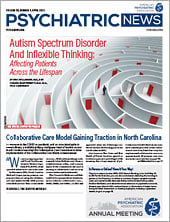People with alcohol use disorder (AUD) were more likely to initiate treatment early in the COVID-19 pandemic compared with the year before the pandemic began, a
study in
Alcoholism Clinical & Experimental Research has found. The results of the study suggest that access to telehealth may have played a role in increased treatment initiation, especially among younger and healthier adults who may have been less likely to seek out and begin treatment before the pandemic.
For lead author Vanessa Palzes, M.P.H., a senior data analyst at the Center for Addiction and Mental Health Research in the Division of Research at Kaiser Permanente Northern California, and colleagues, the pandemic offered a unique opportunity to learn how telehealth might factor into treatment initiation and retention.
“During the pandemic, our health care system, like many others, shifted delivery of care for alcohol use disorder towards telehealth services in order to meet patients’ needs,” Palzes said. “We believed it was important to examine the impacts of this shift on who was able to access and utilize care, including whether it worsened disparities that we know already existed or if it could improve treatment use for different groups of people.”
Palzes and colleagues compared electronic health record (EHR) and claims data collected from 32,806 adults from March to December 2019, before the pandemic, with EHR and claims data collected from 26,763 adults from March to December 2020, early in the pandemic. All patients had either AUD or another alcohol use diagnosis. The researchers found that 32.4% of patients in the study initiated treatment during the early pandemic, compared with 24.2% before the pandemic. In addition, during the pandemic, 20.3% of patients initiated treatment through telehealth, compared with 5.9% of patients before the pandemic. The greatest increases in treatment initiation, with or without telehealth, occurred in patients aged 18 to 34 years.
“For young people, telehealth may have offered an opportunity to explore treatment away from the scrutiny of peers who drink alcohol,” said principal investigator and senior author Stacy Sterling, Dr.P.H., M.S.W., co-director of the Center for Addiction and Mental Health Research in the Division of Research at Kaiser Permanente Northern California.
The researchers also compared treatment initiation, with and without telehealth, among other groups of patients. While treatment initiation increased in patients regardless of whether they had comorbid medical or psychiatric conditions, the increases in treatment initiation were greater in patients who did not have these comorbidities. Treatment initiation increased for all racial and ethnic groups, although the rate of treatment initiation was lower during the pandemic for Black, Latinx, and Asian, Native Hawaiian, or Pacific Islander patients compared with White patients.
In addition, after dividing patient neighborhoods into four quartiles of socioeconomic status, the researchers found that treatment initiation increased for patients in all four quartiles. In fact, patients in the third quartile, who lived in neighborhoods with lower socioeconomic status, had greater increases in telehealth treatment initiation compared with those who lived in neighborhoods with the highest socioeconomic status.
“While we were not surprised that younger adults had some of the greatest increases in use of telehealth, we might have expected that some groups, such as older adults or those with lower socioeconomic status, would have decreased use during the pandemic due to what we call the ‘digital divide,’ but we didn’t see that at all,” Palzes told Psychiatric News, referring to unequal access and use of the internet and digital technology.
Sterling said that the availability of telehealth may have put patients more at ease with seeking help.
“Stigma is frequently a huge barrier to starting addiction treatment for people, and it may be a stronger barrier for certain populations, who may be wary of behavioral health treatment due to perceptions of historical mistreatment or cultural taboos about ‘airing dirty laundry’ in public,” Sterling said. “The ability to engage in treatment in a more private, comfortable, and less-stigmatized setting at home may have encouraged more participation.”
Treatment engagement—defined as having two or more treatment sessions after treatment initiation—increased during the pandemic, as well: 41.4% of patients engaged in treatment after initiating treatment during the pandemic, compared with 34% of those who initiated treatment before the pandemic. Furthermore, 52.6% of those who initiated treatment via telehealth during the pandemic engaged in treatment, compared with 38.1% of those who initiated treatment via telehealth before the pandemic.
“It does seem as though telehealth modalities may be an appealing option for some patients,” said study researcher Caroline Corriveau, M.D., an addiction psychiatrist at Kaiser Permanente in Oakland. “If it is feasible, it may be a good approach to broadening the variety of treatment resources that psychiatrists can offer to patients in order to increase access and satisfaction. Telehealth may also help to increase access in underserved and under-resourced systems, such as rural areas with relatively few specialty treatment providers.”
This study was funded by the National Institute on Alcohol Abuse and Alcoholism and the National Institute on Drug Abuse. ■



